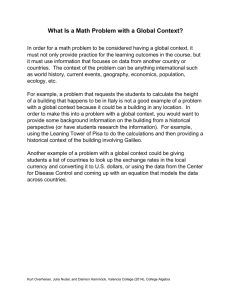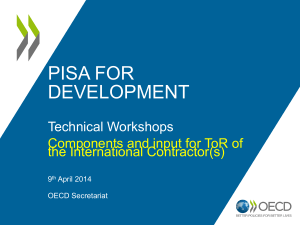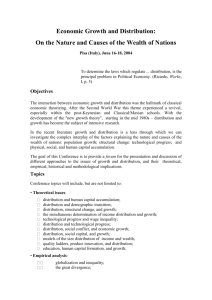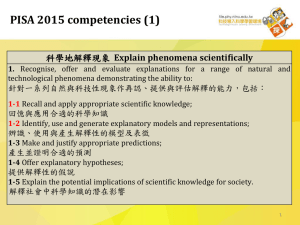Teachers* labor market, PISA and wages
advertisement
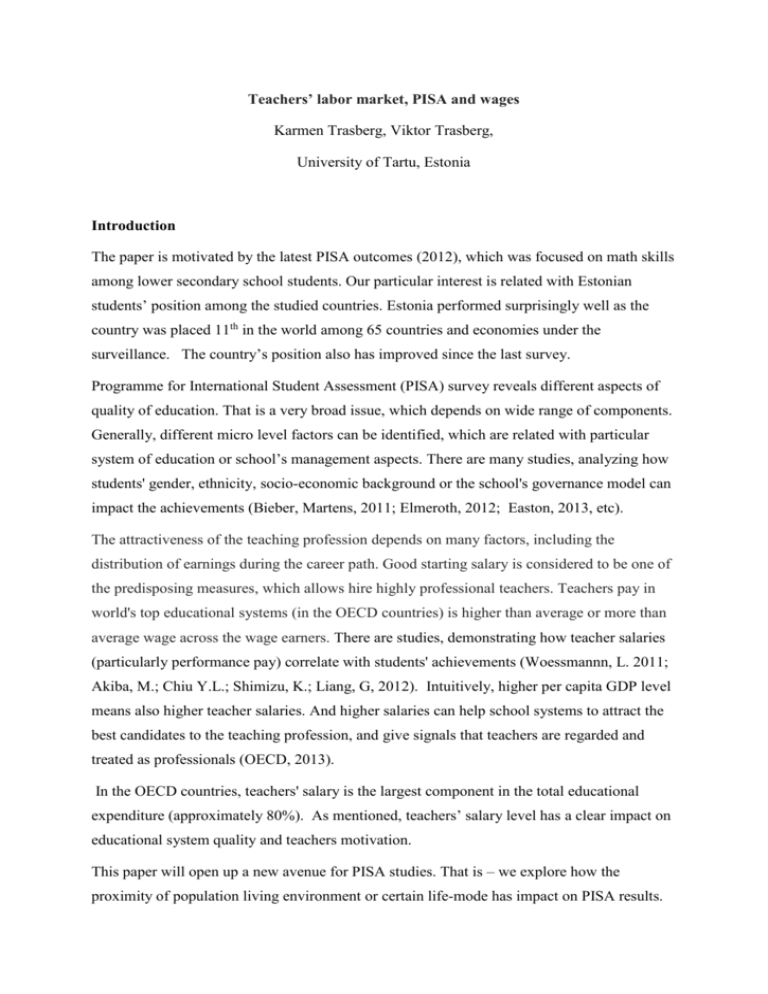
Teachers’ labor market, PISA and wages Karmen Trasberg, Viktor Trasberg, University of Tartu, Estonia Introduction The paper is motivated by the latest PISA outcomes (2012), which was focused on math skills among lower secondary school students. Our particular interest is related with Estonian students’ position among the studied countries. Estonia performed surprisingly well as the country was placed 11th in the world among 65 countries and economies under the surveillance. The country’s position also has improved since the last survey. Programme for International Student Assessment (PISA) survey reveals different aspects of quality of education. That is a very broad issue, which depends on wide range of components. Generally, different micro level factors can be identified, which are related with particular system of education or school’s management aspects. There are many studies, analyzing how students' gender, ethnicity, socio-economic background or the school's governance model can impact the achievements (Bieber, Martens, 2011; Elmeroth, 2012; Easton, 2013, etc). The attractiveness of the teaching profession depends on many factors, including the distribution of earnings during the career path. Good starting salary is considered to be one of the predisposing measures, which allows hire highly professional teachers. Teachers pay in world's top educational systems (in the OECD countries) is higher than average or more than average wage across the wage earners. There are studies, demonstrating how teacher salaries (particularly performance pay) correlate with students' achievements (Woessmannn, L. 2011; Akiba, M.; Chiu Y.L.; Shimizu, K.; Liang, G, 2012). Intuitively, higher per capita GDP level means also higher teacher salaries. And higher salaries can help school systems to attract the best candidates to the teaching profession, and give signals that teachers are regarded and treated as professionals (OECD, 2013). In the OECD countries, teachers' salary is the largest component in the total educational expenditure (approximately 80%). As mentioned, teachers’ salary level has a clear impact on educational system quality and teachers motivation. This paper will open up a new avenue for PISA studies. That is – we explore how the proximity of population living environment or certain life-mode has impact on PISA results. Considering the PISA 2012 results, we are witnessing some very striking differences between the best and worst performers. In the highest positions are the countries which are extremely urbanized or have a very high population density (Table 1). In the PISA ranking, in the top 6 are 5 countries with urbanization rate of 100 percent1. The opposite end countries are characterized as countries with significantly lower urbanization rates and with considerably smaller population density levels. Table 1. PISA ranking and population allocation PISA math rank number 1 2 3 4 5 6 7 8 9 10 11 …… 59 60 61 62 63 64 65 67 68 69 Shanghai-China Singapore Hong Kong-China Chinese Taipei South-Korea Macao-China Japan Liechtenstein Switzerland Netherlands Estonia 613 573 561 560 554 538 536 535 531 523 521 100 100 100 100 83 100 79 22 67 90 79 Population density, persons per km2 3,700 7,669 6,516 646 505 20,069 337 230 196 404 30 Costa Rica Albania Brazil Argentina Tunisia Jordan Colombia Qatar Indonesia Peru 407 394 391 388 388 386 376 376 375 368 60 43 82 88 6 79 75 93 42 73 91 98 23 14 66 74 42 175 124 23 CountryTerritory PISA math result Urbanization rate Source: PISA 2012 Report; CIA World Factbook. This leads to the question – how does the population living environment particularities (similarities or dissimilarities) influence the PISA results? Therefore, a keyword for our study is homogeneity. In other words – homogeneous living environment is positively correlated with PISA results. Intuitively, if the population density or 1 Interesting case is Liechtenstein. Country has rather limited territory and size of population. Most of population is residing areas, which is considered as rural. However, the population density in Liechtenstein is very high. 2 compactness is high, the PISA results are more homogeneous. Our working hypothesis is that successful countries are those where students live broadly in comparable (homogenous) conditions. Additionally, the high density should be considered in combination with urban environment. Therefore, those two factors – urbanization and territorial compactness of societies is supporting PISA performance. Compactness, which is measured by the population density and urbanization rate, puts hypothetically schools (and student body) into more similar conditions. Variance of schools standards, curricula and teaching quality is smaller, than in the large territories with sparsely located population. More homogeneous living mode (e.g. urban), in turn, makes school systems more heterogeneous. In opposite, if countries have different regions with different life modes (e.g urban and rural) and those regions are spread widely over country’s territory – also the school differences will increase. The schools become then more diverse and as an outcome, the schools’ quality and educational standards became more heterogeneous. Such a heterogeneity transfers into higher PISA results variance and differentiation. Considering that, the paper brings out some correlations between PISA results and countries homogeneity factors – like urbanization, population density and income inequality. Separately will be characterized teachers’ salaries impact on PISA results. Estonian PISA performance factors are also analyzed in those frames. What is PISA? The Programme for International Student Assessment (PISA) is an international survey, organized by the OECD which aims to evaluate education systems worldwide by testing the skills and knowledge of 15-year-old pupils. To date, students representing more than 70 economies have participated in the assessment. Since 2000, every three years, fifteen-year-old students from randomly selected schools worldwide take tests in the key subjects: reading, mathematics and science, with a focus on one subject in each year of assessment. In PISA 2000 and 2009 reading literacy was the main domain, PISA 2003 and 2012 focused on mathematics and PISA 2006 had science as the major domain. PISA offers insights for education policy and practice, and that helps monitor trends in students’ acquisition of knowledge and skills across countries and in different demographic subgroups within each country. Results reveal by showing what students in the highestperforming and most rapidly improving education systems can do. The findings allow policy3 makers around the world to gauge the knowledge and skills of students in their own countries in comparison with those in other countries, set policy targets against measurable goals achieved by other education system, and learn from policies and practices applied elsewhere. Estonian results in PISA Estonia has participated in PISA 2006, 2009 and 2012 cycles. In the last cycle - 206 Estonian schools participated, 166 schools were with Estonian as the language of instruction, 37 with Russian as language of instruction and 3 mixed language schools. 79% of the students (about 3800) took the test in Estonian and 21% of the students (995) took it in Russian. As the total number of 15 year-olds in Estonia in 2012 was 12 439, almost half of the PISA age cohort was assessed. The results showed that the performance of Estonian 15-year old students ranks among the top achievers. In European comparison, Estonia share 3.-6. place with the Netherlands, Finland and Poland. Among all participating countries Estonia ranks 10 - 14. Also the students attitudes toward learning are favourable - 81% of Estonian students think that mathematics is important and they will need it in their future studies. 76% of Estonian students are satisfied with their school, 66% of the Estonian students say they feel happy at school. As a rule, the happiness factor and student performance are linked weakly in most countries - the happiest students are in countries where the performance is lower. There are several reasons behind good results and the following could be highlighted: (a) Estonian student performance is not influenced by student socio-economic background. Performance in mathematics is not affected by student socio-economic background - more than a third of students with low socio-economic background are among the best performers. It is caused by implementing principles of comprehensive school, broad national curriculum for all students and tutoring of low achievers, relatively small classroom size, subsidized school meal in lower secondary school etc. (b) Lowest amount of low proficiency students in Europe. Estonia is among the top countries that have the smallest amount of students that have not reached the baseline - second proficiency level. Students at this level should be able to manage in everyday life. Most of Estonian students have reached this level in all three 4 assessment domains (in reading 90,9% of students, in maths 89,5% of students, in science 95%). The trend during the six years has been positive (Summary of PISA 2012 results for Estonia). At the same time PISA results draws attention to problem areas, which need attention and further carefully considered actions - there is a performance gap between urban ( big towns 534 p, small towns 518 p) and rural schools (509 p). The big variability of student performance rise the question - why schools in Tallinn, Tartu or on the islands are the best performers, but counties show more modest results. There are also big regional differences – in math the performance gap between Hiiu county (the best performing in Estonia) and IdaViru county is 62 points, which corresponds to one and half school year. The performance of students from Russian medium schools is significantly lower than for students in Estonian medium schools. In comparison to PISA 2006 and 2009 the performance of Russian students has improved, however, but the gap is still big – 36 score points which can be considered as close to one year of schooling. This means that students, graduating Russian medium comprehensive schools are significantly less prepared to make choices concerning further studies and participation in lifelong learning. Teachers pay and PISA As it was demonstrated, teachers’ salary is highly correlated with PISA results. In turn, teachers’ salary depends on country’s GDP level. An OECD thematic report “Does performance-based pay improve teaching?” used evidence from PISA to identify whether recognizing and rewarding teaching performance through pay raises student attainment. About half of the OECD countries participating in PISA reward teacher performance financially. Some high performing education systems have used performance-based pay while others have not. Examination of the overall picture revealed no relationship between average student performance in a country and the use of performancebased pay schemes for teachers. The picture changed when taking into account how well teachers had been paid overall in comparison with national income. The report suggested that even if performance based pay is a viable policy option, it is important to know how to implement the system effectively (OECD, 2012). 5 Salaries are just one of many factors that motivate teachers, but they are a key consideration in attracting the best candidates and retaining the best teachers. Low salaries are likely to damage morale and can lead teachers to switch to other careers. At the same time, teacher salaries make up the largest share of most education budgets, so they need to be set at a realistic level to ensure that enough teachers can be recruited. The level of teacher salaries influences education quality (UNESCO, 2014). Salaries in terms of the purchasing power of the lower side of the transition countries are followed (like in Estonia, Hungary, Czech Republic), where the starting salary as a well as service-length related salary wage growth were relatively small. However, should be noted that this is only a salary level; it will not take into account other bonuses for novice teachers to be supported (e.g. a young teacher start-up money, etc..). The study also analyzed the relationship between teachers' salaries and student achievements. PISA results show that in the number of countries educational investments correlate with the academic performance (Finland, Japan, Korea). However, the certain countries, where education spending is relatively low, achieved excellent results (including Estonia). And the converse is also true - Austria, France, Germany having relatively high educational expenditure, but the results are average or below of the OECD indicators. It turned out that the good results and earnings are positively related in Asian countries, as well as the Netherlands. In the Nordic countries, high level of wages is linked with high performance in Finland. Estonia excels in high PISA results, but the teachers' salaries are in the lowest pay segment. Consequently, we expect that Estonia's current teacher’s effective work is related with some other motives - whether it be a teacher social status, confidence, mental and physical working environment, the long summer holidays, social security, etc. However, the teaching profession at the current wage conditions will not be attractive and motivating for the younger generation in the long term. Homogeneity and PISA How PISA results correlate with homogenity factors? In following are studied European countries (33 countries) PISA results and correlation with various indicators (Table 2) 6 Table 2. Correlations between PISA and homogeneity indicators Pop PISA GDP Gini Density2 math result per capita coefficient Person per 2012 EUR, 2012 km2 PISA math result 2012 1 GDP per capita EUR, 2012 0.500** Gini coefficient 0.472** Population density2, person per km2 0.342* Urbanization rate 0.394* Teachers’ minimal salary, EUR, 20123 0.433** 0.500** 1 -0.493** -0.472** Urbanization rate2 0.342* -0.493** 1 -0.129 Teachers min salary EUR, 20123 0.394* 0.433** 0.572** 0.951** -0.315* -0.345* 0.367* 1 0.572** -0.315* 0.951** -0.345* 1 0.367* 0.561** 0.561** 1 Source: Eurostat1 and World Bank2 database; Eurydice3 (lower secondary student teachers) ** Correlation is significant at the 0.01 level; * Correlation is significant at the 0.05 level There are chosen set of indicators, which were named earlier. Urbanization rate, population density and Gini coefficient has chosen as homogenity indicators. GDP level per capita and teachers salary level are additional components in explaining PISA results. Intuitively, they should be closely related with each other and also with urbanization rate. In the table are presented only those correlation levels, which are statistically significant. As the table presents, PISA results correlate significantly with all presented indicators. What the correlations tell us? Countries GDP per capita level is strongly and positively correlated with PISA. Similarly, it is highly correlated with teachers’ salary. Those are rather expected outcomes. Similarly, level of teacher’s salary is positively related with PISA results, urbanization and population density. One can say that in the urban schools have higher teacher salaries, which in turn, have a positive effect on PISA results. Separately will be teachers’ pay systems and level issues explained below. High Gini coefficient level indicates widespread income differences in society. However, the coefficient level is not very clearly related with country’s GDP level. For example, Finland and Belarus have about same level of income inequality. However, their income levels differ 7 manifold. Therefore, it is intuitively difficult to predict the strength and sigh of relationship between income inequality and PISA results. Although, as the correlation level demonstrates, the Gini coefficient is strongly, but negatively related with the PISA outcomes. That is – higher income inequality level means also lower PISA result! Heterogeneity of society’s incomes affects PISA result negatively. Also, a society with high income differences is lower teacher salary level. The table presents that population density and urbanization level is positively correlated with PISA results. That outcome is in accordance with our hypothesis, that homogeneity in living mode has positive impact on higher PISA results. To conclude this sub-chapter, it is possible to find statistically significant correlations between homogeneity characteristics and PISA outcomes. Nevertheless, correlative links do not proof causality relationships between the variables. In the next, an econometric model is generated to expose homogeneity factors impact on PISA results. Does homogeneity factors have impact on PISA outcomes? There was constructed linear OLS simple regression model to test earlier named factors impact on PISA score. PISA score = b0 + b1 factor + ε Dependent variable: PISA score in points Predictors (factors): GDP per capita ; Gini coefficient ; Population density; Urbanization rate Individual tests confirm statistically significant impact on PISA score. Therefore, the regressions’ outcomes go hand-in-hand with earlier correlation results. Definitely, all those variables explain only a part of score fluctuations. In following was tested the same factors in combination to explain the PISA score variations. A multiple regression model was constructed in a following way: 8 PISA result = b0 + b1 GDP per capita + b2 Gini + b3 Pop.Density + b4 Urbanization + ε se (510.06) (0.00) (1.179) (0.047) (0.477) t 10.13 0.692 -1.809 1.204 0.801 0.495 0.082 0.024 0.043 Sig. R2 = 0.338 0.000 Adjusted R2 = 0.240 dfregression = 4 dftotal = 31 F= 3.448 Sig.= 0.021 As the test results indicate, those factors as provided such a combination have an impact on PISA results. The model F-test indicates statistical significance. However, those variables explain only 24% of variation of PISA outcomes. Despite the general significance of the model, the variables individually do not proof their significant impact on PISA results. Therefore, in the current combinations those variables proof positive impact of homogenity factors to the PISA outcomes. Conclusions There are various factors, which have clear impact on PISA results - like nation income level, teachers’ motivation aspects or school's governance model. In this paper we discussed some other factors - like urbanization, population density and income inequality which might have impact on the PISA score. Those are named as homogeneity factors. We argue that high urbanization rate and population density equalizes school standards and therefore, increases student achievement. Otherwise, countries with extensive territories and different life modes have lower PISA outcomes due to high variance in school quality. Correlation analyses, which included a set of European countries, supported that an argument. However, regression analyses do not show strong causal relationship between homogeneity factors and PISA score. The study also analyzed the relationship between teachers' salaries and student achievements. PISA results show that in the number of countries educational investments correlate with the academic performance. And there are countries with relatively high educational expenditure, but the results are average or below of the OECD indicators. It turned out that the good results and earnings are positively related in Asian countries, as well as the Netherlands. In the Nordic countries, high level of wages is linked with high performance in Finland. Estonia excels in high PISA results, but the teachers' salaries are in the lowest pay segment. 9 References: Akiba, M.;, Chiu Y.L.; Shimizu, K.; Liang, G, (2012). Teacher salary and national achievement: A cross-national analysis of 30 countries. International Journal of Educational Research, 53. Bieber, T.; Martens, K. (2011). The OECD PISA Study as a Soft Power in Education? Lessons from Switzerland and the US. European Journal of Education, 46, 1. Easton, B. (2013). Ethnicity, gender, socioeconomic status and educational achievement: An exploration New Zealand Post Primary Teachers' Association (PPTA). Wellington. Elmeroth, E. (2012). Winners and Losers in the Swedish School System: an International Perspective. Race, Gender & Class, 19, 3/4. Eurydice (2013) Teachers’ and School Heads’ Salaries and Allowances in Europe, 2012/13. Retrieved 20.02.2014 http://eacea.ec.europa.eu/education/eurydice/documents/facts_and_figures/salaries.pdf Eurostat Homepage. Retrieved 20.02.2014 http://epp.eurostat.ec.europa.eu/portal/page/portal/eurostat/home/ OECD (2012) PISA in Focus 16. Does performance-based pay improve teaching? Retrieved 02.03. 2014 http://www.oecd-ilibrary.org/education/does-performance-based-pay-improveteaching_5k98q27r2stb-en OECD (2013) PISA 2012 Results: What Makes Schools Successful? Resources, Policies and Practices. Vol IV. Summary of PISA 2012 results for Estonia (2013). Estonian Ministry of Education and Research. UNESCO (2014) Teaching and learning. Achieving quality for all. EFA Global Monitoring Report. CIA World Factbook. Retrieved 02.03. 2014 https://www.cia.gov/library/publications/theworld-factbook/ Woessmann, L. (2011) Cross-country evidence on teacher performance pay. Economics of Education Review, 30. 10

